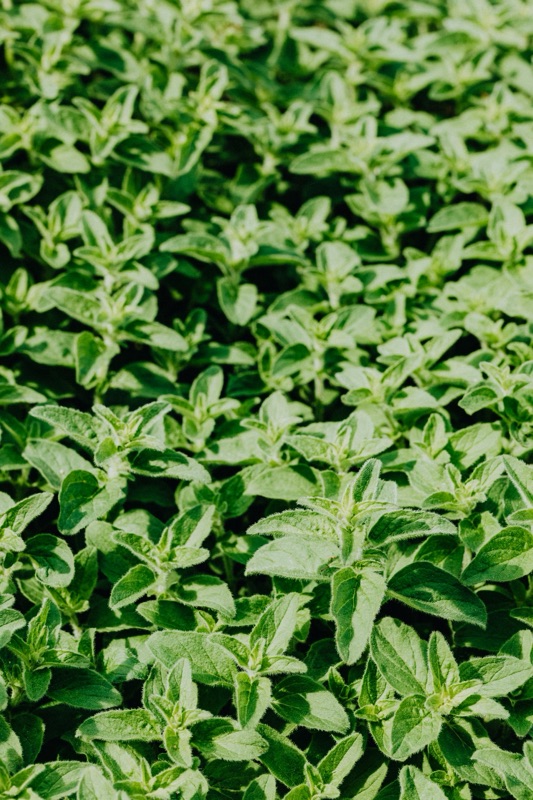Oregano
by Wanderer MoonChild
Botanical Basics
- Common Name(s): Oregano, Wild Marjoram
- Folk Name(s): Joy of the Mountain, Mountain Mint, Wild Hyssop
- Scientific/Latin Name: Origanum vulgare
- Family: Lamiaceae (Mint family)
- Plant Type: Hardy perennial herb
- Botanical Description: A bushy, aromatic herb with square stems, oval to lance-shaped dark green leaves, and clusters of tiny purple to pink flowers. Typically grows 1–2 feet tall and spreads readily.
- Growing Zones/Climate: USDA Zones 4–10; prefers warm, dry, temperate to Mediterranean climates.
- Best Zones for Growth: Performs best in Zones 5–9 with hot summers.
- Habitat & Range: Native to Europe, the Mediterranean, and Western Asia; now naturalized and cultivated worldwide.
Cultivation & Harvest
- Soil & Sun Requirements: Thrives in well-drained, sandy or rocky soil with full sun. Avoid heavy, waterlogged soil.
- Propagation: Propagated by seed, cuttings, or root division. Seeds are slow to germinate; cuttings establish more quickly.
- Companion Planting: Good companion for tomatoes, peppers, and beans; repels pests such as aphids.
- Harvesting Guidelines: Harvest sprigs just before or during flowering for maximum flavor and potency. Best harvested in the morning once the dew has dried.
- Drying/Preservation: Air-dry bunches in a dark, ventilated space; also freezes well and can be infused in oils or vinegars.
Traditional & Historical Use
- Cultural Significance: The name “oregano” comes from Greek meaning “joy of the mountain.” In Greek and Roman cultures, it was associated with love, happiness, and protection. Used in weddings as crowns and garlands.
- Traditional Medicine: Employed as a digestive aid, antimicrobial, and respiratory support in Mediterranean folk medicine. Infusions and poultices were used for coughs, colds, and wounds.
- Symbolism: Symbol of joy, peace, and lasting love.
Medicinal & Practical Properties
- Active Constituents: Carvacrol, thymol, rosmarinic acid, flavonoids, tannins, essential oils.
- Medicinal Uses:
- Antimicrobial and antifungal (internal and external use).
- Digestive support—relieves bloating, cramps, and indigestion.
- Respiratory support for colds, coughs, and bronchitis.
- Antioxidant and immune-enhancing.
- Preparation Methods:
- Infusion/tea (leaves).
- Oil of oregano (concentrated extract, diluted).
- Tincture or capsules.
- Poultices or washes for skin infections.
- Dosage & Guidelines: Tea—1–2 tsp dried herb per cup, steep 10 minutes; 2–3 cups/day. Oil of oregano—highly concentrated; typically 1–2 drops diluted in carrier oil or water (external use or under supervision internally).
- Safety/Precautions: Essential oil is very strong—always dilute. Avoid medicinal doses during pregnancy. May cause allergic reaction in those sensitive to Lamiaceae plants.
Magical & Spiritual Properties
- Elemental Association: Air & Fire
- Planetary/Deity Correspondence: Venus and Aphrodite (love, joy), Mars (protection, strength).
- Magical Correspondences: Joy, love, peace, protection, health, prosperity.
- Ritual Use: Added to love charms, dream pillows, and protection sachets; burned as incense for peace and happiness; used in offerings to deities of love and abundance.
- Symbolism in Divination/Dreams: Dreaming of oregano can indicate joy entering life, a blessing of love, or the need for healing and protection.
Ecological & Culinary Uses
- Pollinator Value: Excellent nectar source for bees, butterflies, and other pollinators.
- Wildlife Uses: Provides food for insects; dense growth offers habitat for small creatures.
- Culinary Uses: Staple herb in Mediterranean cooking—used in tomato sauces, pizzas, grilled meats, vegetables, and herbal vinegars. Often paired with basil, thyme, and rosemary.
Household/Practical Uses
- Quick Uses: Flavoring, herbal tea, insect repellent, antibacterial wash.
- Notable Traits: Strong antimicrobial activity; one of the most potent culinary herbs medicinally.
- Special Notes: Oil of oregano is considered “natural penicillin” in some traditions due to its broad-spectrum antimicrobial properties.

Supporting Notes
- References:
- Grieve, M. A Modern Herbal
- Hoffman, D. Medical Herbalism
- Chevallier, A. Encyclopedia of Herbal Medicine
- Cunningham, S. Cunningham’s Encyclopedia of Magical Herbs
No comments:
Post a Comment